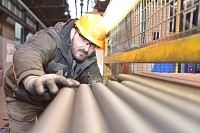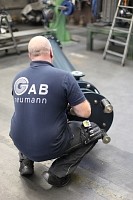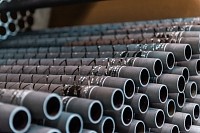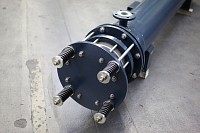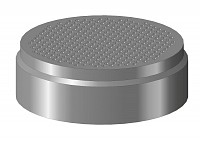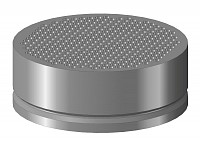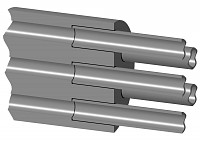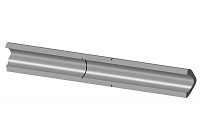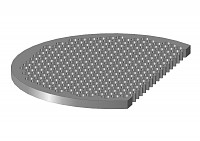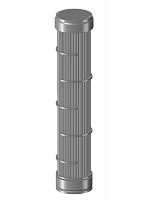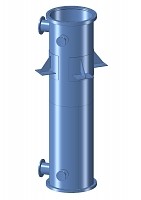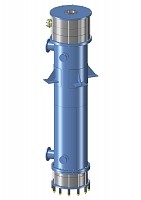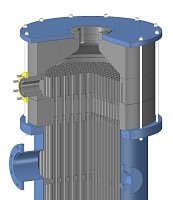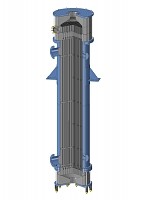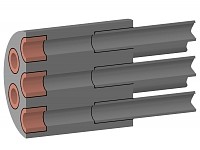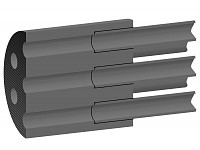Graphite shell and tube heat exchangers
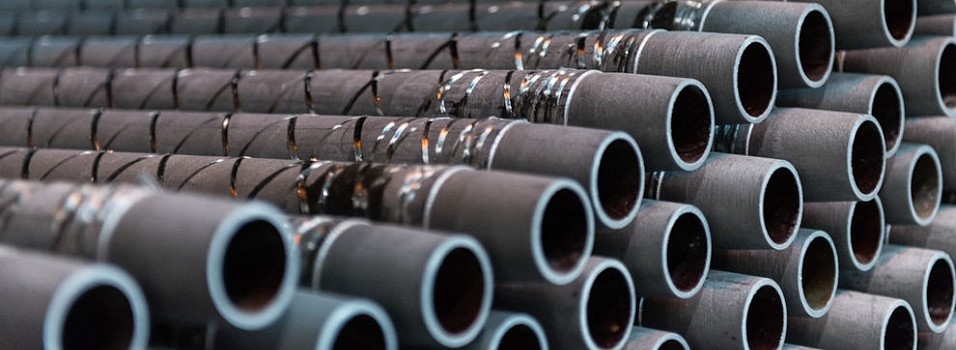
Graphite shell and tube heat exchangers are suitable for heating, cooling, condensing, evaporating or absorbing large flow rates of ultra-corrosive chemicals. This type of graphite heat exchanger is particularly versatile and all conceivable applications are possible. Graphilor® 3 graphite tubes are extruded, sintered and thoroughly impregnated with phenolic resin. Graphite tube sheets are manufactured from graphite block material. The tubes are cemented into the graphite tube sheets to produce the tube bundle which is inserted into the shell. The heat transfer takes place by heat conduction through the graphite tube walls between the process side and the service side.
Snapshots
Small graphite shell and tube heat exchanger
GAB Neumann's offers small (from 10 m2) to very large (up to 1850 m2) graphite shell and tube heat exchangers.
Inspection of Graphilor® 3 tubes
Visual inspection of Graphilor® 3 graphite tubes after extrusion. Graphilor® 3 graphite tubes are thoroughly inspected throughout their entire production process. Every single tube is tested at high pressure.
Visual inspection of a small graphite shell and tube heat exchanger
Visual inspection of a small graphite shell and tube heat exchanger
Carbon fiber reinforced Graphilor® 3 tubes
Graphilor® 3 tubes are extruded, sintered, impregnated, and machined in France. GAB Neumann manufactures all the other components and assembles the graphite shell and tube heat exchanger in its production facility in Maulburg, Germany.
Floating header of a graphite shell and tube heat exchanger
GAB Neumann's graphite shell and tube heat exchangers are equipped with a floating tube sheet and a set of springs to allow the differential thermal expansion between the graphite tube bundle and the steel shell.
3D Renderings
Fixed graphite tube sheet
GAB Neumann's graphite shell and tube heat exchangers are fitted with a fixed and a floating tube sheet.
Floating graphite tube sheet
GAB Neumann's graphite shell and tube heat exchangers are fitted with a fixed and a floating tube sheet.
Graphite tube / graphite tube sheet connection
All graphite tube ends are machined before being cemented into the fixed and the floating tube sheets to form the tube bundle.
Graphite tube / graphite tube connection
Graphilor 3 tubes are monolithic up to 6.21 meters. Longer tubes can be assembled by cementing tube pieces together.
Graphite single segmental baffle
Most GAB Neumann's graphite shell and tube heat exchangers are fitted with graphite single segmental baffles. If needed other baffle arrangements can be offered. Other materials of construction such a steel, stainless steel, or reactive metals can also be offered..
Graphite tube bundle
GAB Neumann's graphite tube bundles consist of graphite tubes, tube sheets, and segmental baffles. All the tubes are cemented in the tube sheets.
Steel shell
GAB Neumann's graphite shell and tube heat exchangers can be fitted with a steel, stainless steel, rubber lined steel, PTFE lined steel, glass lined steel, fiber reinforced plastic, or a reactive metal shell among other materials of construction.
Graphite shell and tube heat exchanger
GAB Neumann offers a wide range of graphite shell and tube heat exchangers. They can be equipped with all kinds of optional features to precisely meet the customers' requirements. Headers can be manufactured in graphite, glass lined steel, PTFE lined steel, rubber lined steel, reactive metals, fiber reinforced plastics, among other materials of construction.
Top headers of a graphite shell and tube falling film absorber or evaporator
Top headers of a graphite shell and tube falling film absorber or evaporator
Graphite shell and tube falling film absorber
GAB Neumann's graphite shell and tube falling film absorber are fitted with a liquid distributor at the top and can be fitted with a gas liquid separation at the bottom.
Amorphous carbon inserts
GAB Neumann's cements amorphous carbon inserts at the inlet of each tube to protect the tube sheet against erosion.
Rigilor® protection against erosion
GAB Neumann offers the Rigilor® protection against erosion. This consists in a carbon fiber fabric bonded to the surface of the tube sheet.
3D animations
Materials:
- Tubes: Graphilor® 3 XBS
- Tube sheets: impervious graphite GAB GPX1, GPX1T ou GPX2
- Headers: impervious graphite GAB GPX1, GPX1T ou GPX2, PTFE lined steel, glass lined steel, rubber lined stell (other materials of construction on request)
- Pressure plates and flanges: carbon steel or stainless steel
- Shell: carbon steel, stainless steel, reactive metals (other materials of construction on request)
- Tie rods, nuts, bolts, washers, springs: stainless steel
Design:
- 4 different tube diameters: 16/25, 32/22, 37/25 or 51/38 mm
- Modular design: number of tubes and tube length can be adjusted
- Maximum tube length: 6,21 metres without connection, 9,0 metres with connection
- Multiple passes possible
- Maximum tube sheet diameter: 2100 mm
- Numerous materials available for the headers and the shell
- Compensation of thermal expansion ensured by tie rods and springs
- Carbon fiber reinforced tubes (optional)
Key features:
- Design pressure: -1 barg (full vacuum) to + 7 barg (105 psig) on the tube side and to + 11 barg (165 psig) on the shell side
- Design temperature: -30 to +200°C (-22 to 392°F)
- Heat transfer area: 10 m2 to 1850 m2 (100 ft2 to 20000 ft2)
- Design: according to European Pressure Equipment Directive 2014/68/EU (PED) or ASME Code
Key Benefits:
- Large heat transfer surface
- Outstanding corrosion resistance
- Superior heat transfer performance thanks to adjustable cross sections both on tube and on shell sides
- High operational safety
- Highly reliable equipment therefore low cost of ownership and low maintenance cost
- Sturdy design
- Short lead time
- Long lifetime
Optional features:
- Water cooled header (for elevated incoming gas temperatures)
- Liquid distributor (falling film absorber or evaporator)
- Gas liquid separation chamber (condenser)
- Carbon fiber reinforced tubes
- Protection of the tube sheets against erosion
Main applications:
- Heating, cooling, condensation, or evaporation of ultra-corrosive chemicals
- Absorption ultra-corrosive gases
Technical documentation:
Shell and tube heat exchangers
Shell and tube heat exchangers transfer heat from one medium to another medium without direct contact between fluids. A shell and tube exchanger consists of a shell, tube bundle and two headers at both ends. Two fluids, of different starting temperatures, flow through the heat exchanger. One flows through the tubes (the tube side) and the other flows outside the tubes but inside the shell (the shell side). Heat is transferred from one fluid to the other through the tube walls. The fluids can be either liquids or gases on either the shell or the tube side.
The thermal performance of shell and tube heat exchangers can vary significantly. It is therefore essential to select the type and size of heat exchanger that are the most adapted to the specific application and industrial process. There are a number of considerations including flow rate, pressure drop, risk of erosion, design pressure and temperature, material compatibility, fouling, and many more that should be taken in account.
GAB Neumann’s graphite shell and tube heat exchangers – GR series
GAB Neumann’s graphite shell and tube heat exchangers are designed to cool down or heat up ultra-corrosive chemicals. Safety, reliability, and performance on the long-term are our primary considerations when we size, design and manufacture graphite shell and tube heat exchangers.
Our extended and highly customizable heat exchangers portfolio enables us to provide particularly adapted solutions. All our graphite shell and tube heat exchangers’ designs are totally modular to best fit with individual process specifications. The diameter, number, and length of tubes, the number of passes on tube side, the type, number, and opening of baffles on the shell side can be set to best meet the velocities, pressure drops, and heat transfer requirements.
They can be fitted with optional features such as carbon fiber reinforcement, liquid distributor, cooled headers, or gas liquid separation chambers among others.
Industrial processes:
- Phosphoric acid
- Fumed silica
- Silicones
- Titanium dioxide
- Polycarbonate
- Coagulants
- Treatment, purification and concentration of spent acids
- Sulfuric acid dilution
- and many more…
GAB Neumann GmbH
Alemannenstrasse 29
79689 Maulburg
Germany
GAB Neumann GmbH | Alemannenstrasse 29 | D-79689 Maulburg | Phone +49 (7622) 6751 0 | Fax +49 (7622) 6751 20 | E-Mail info@gab-neumann.de | www.gab-neumann.com



